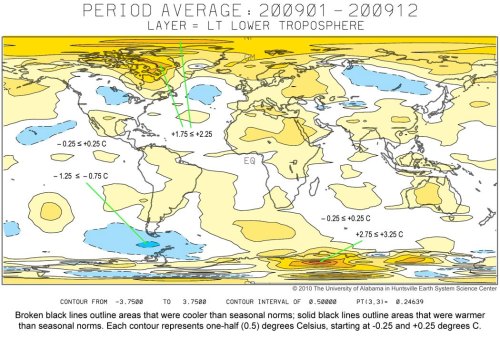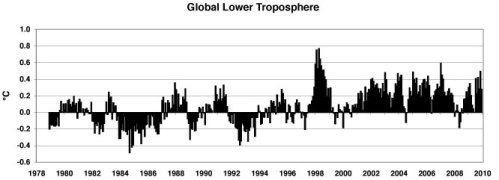Global Lower Tropospheric Temperature Report: December 2009 And For The Year 2009
Global Lower Tropospheric Temperature Report: December 2009 And For The Year 2009.Monday, January 11th 2010, 4:01 pm
Global Lower Tropospheric Temperature Report: December 2009 And For The Year 2009
The December 2009 and year 2009 University of Alabama at Huntsville lower tropospheric MSU temperature data is available. Thanks to Phillip Gentry and John Christy for alerting us to these figures]. I have several comments following the figures.
This data shows why the focus needs to be on the regional scale and that a global average is not of much use in describing weather that all of us experience.
The news media seem to continue to avoid this perspective. For example, in the article Snow, ice and the bigger picture
excerpts read
"Rather than seeking vindication or catastrophe in this cold snap, now is a good time to remind ourselves that weather, like death and taxes, will always be with us. Spectacular regional swings in temperature and precipitation, sometimes lasting for months, often emerge from the natural jostlings of atmosphere and ocean. By themselves, none of these prove or disprove a human role in climate change."
"What's different now is that climate change is shifting the odds towards record-hot summers and away from record-cold winters. The latter aren't impossible; they're just harder to get, like scoring a straight flush on one trip to Vegas and a royal flush the next."
"If you're craving a scapegoat for this winter, consider the Arctic oscillation. The AO is a measure of north-south differences in air pressure between the northern midlatitudes and polar regions. When the AO is positive, pressures are unusually high to the south and low to the north. This helps shuttle weather systems quickly across the Atlantic, often bringing warm, wet conditions to Europe. In the past month, however, the AO has dipped to astoundingly low levels – among the lowest observed in the past 60 years. This has gummed up the hemisphere's usual west-to-east flow with huge "blocking highs" that route frigid air southward."
"Handy as it is, the AO describes more than it explains. Forecasters still don't know exactly what sends the AO into one mode or the other, just as the birth of an El Niño is easier to spot than to predict."
See also the post at Dot Earth by Andy Revkin titled Cold Arctic Pressure Pattern Nearly Off Chart
The obvious response to these claims is that if we cannot predict weather features such as the Arctic oscillation or an El Niño under current climate, how can anyone credibly claim we have predictive skill decades into the future from both natural and human caused climate forcings? The short answer is that they cannot.
The article concludes with the text
"If this winter tells us anything, it's that we'll have to remain on guard for familiar weather risks as well as the evolving ones brought by climate change."
This admission implicitly recognizes the focus on the reduction of vulnerability that we wrote about in our paper
Pielke Sr., R., K. Beven, G. Brasseur, J. Calvert, M. Chahine, R. Dickerson, D. Entekhabi, E. Foufoula-Georgiou, H. Gupta, V. Gupta, W. Krajewski, E. Philip Krider, W. K.M. Lau, J. McDonnell, W. Rossow, J. Schaake, J. Smith, S. Sorooshian, and E. Wood, 2009: Climate change: The need to consider human forcings besides greenhouse gases. Eos, Vol. 90, No. 45, 10 November 2009, 413. Copyright (2009) American Geophysical Union.
The media, policymakers and others should recognize this evidence of our incomplete understanding of the climate system. We will continue to have surprises such as we have seen this winter.
More Like This
January 11th, 2010
March 22nd, 2024
March 14th, 2024
February 9th, 2024
Top Headlines
April 19th, 2024













